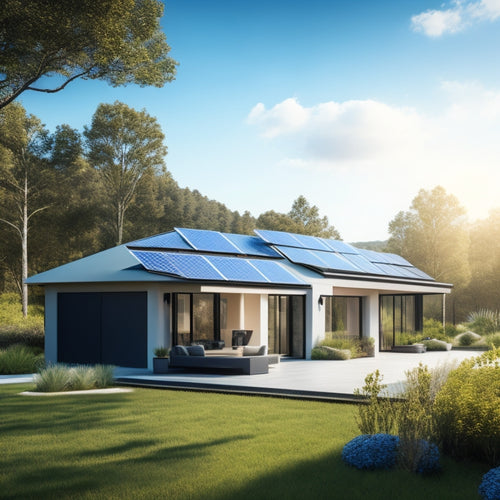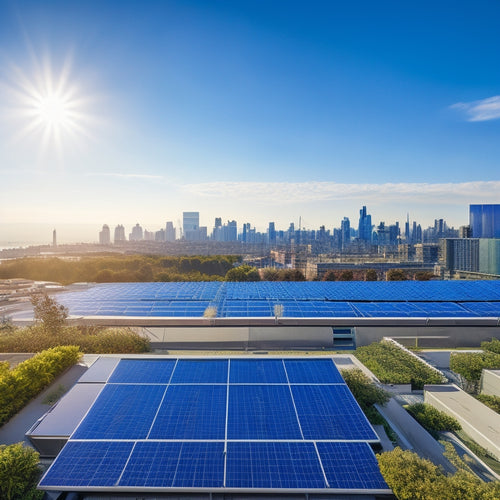
What Is the Total Cost to Buy and Install Solar Panels
Share
You can expect to pay between $15,000 and $22,000 for a typical residential solar panel system, with an average cost of $2.50 to $3.50 per watt. This includes the cost of the panels themselves, installation labor costs, inverter and mounting hardware, and local permitting and inspection fees. Additionally, you'll need to factor in ongoing expenses like monitoring and maintenance, as well as potential repair and replacement costs. However, you'll also benefit from federal and state tax incentives, and significant long-term savings on your energy bills. As you consider your solar investment, there are many variables to weigh - and understanding each of these factors will help you make an informed decision.
Key Takeaways
- The average cost of solar panels ranges from $2.50 to $3.50 per watt, with typical residential systems costing between $15,000 and $22,000.
- Installation labor costs typically range from $2,000 to $5,000, depending on project complexity and installer expertise.
- Inverter and mounting hardware costs add $1,500 to $3,000 to the total cost, with quality considerations crucial for the system's performance.
- Roof and site factors, such as size, orientation, and shading, impact the number of panels needed and overall installation costs.
- Federal and state tax incentives, like the 26% federal tax credit, can significantly reduce the total cost of buying and installing solar panels.
Average Cost of Solar Panels
As you consider switching to solar energy, understanding the average cost of solar panels is essential in determining whether this investment is right for you. The average cost of solar panels varies depending on the type and quality of the panels.
There are three main solar panel types: monocrystalline, polycrystalline, and thin-film. Monocrystalline panels are the most efficient and expensive, while thin-film panels are the least efficient and least expensive. On average, the cost of solar panels ranges from $2.50 to $3.50 per watt. For a typical residential solar panel system, the total cost would be around $15,000 to $22,000.
Financing options can greatly impact the upfront cost of solar panels. You can choose to pay cash, take out a loan, or lease the system. Loans and leases often come with lower upfront costs, but you'll pay more in the long run due to interest rates.
Additionally, government incentives and tax credits can help reduce the cost of solar panels. By understanding the average cost of solar panels and exploring financing options, you can make an informed decision about switching to solar energy.
Installation Labor Costs Breakdown
How much of your total solar panel cost goes towards installation labor? This component accounts for a significant portion of your overall expenditure. On average, installation labor costs range from $2,000 to $5,000, depending on the complexity of the project and the installer's proficiency.
The labor cost breakdown includes factors such as the installer's experience, labor training, and installation techniques used. For instance, a certified installer with extensive experience may charge a higher rate compared to a less experienced one.
The type of installation techniques employed, such as roof-mounted or ground-mounted systems, also impact labor costs. Additionally, the complexity of the project, including the number of panels and inverters required, affects the labor hours needed to complete the job.
When evaluating installation labor costs, it's crucial to assess the quality of work, warranty offered, and customer support provided. Reputable installers may charge higher labor rates, but they often provide superior workmanship and after-sales service, ensuring your solar panel system operates efficiently for years to come.
Roof Size and Complexity Factors
Your roof's size and complexity play a significant role in determining the total cost of your solar panel system. A larger roof requires more solar panels, which increases the overall cost. Additionally, a complex roof with multiple angles, skylights, or obstructions can make installation more challenging, leading to higher labor costs.
To give you a better understanding of how roof size and complexity impact costs, consider the following factors:
-
Roof size: A larger roof requires more solar panels to generate the same amount of power, increasing the total cost of the system.
-
Roof orientation: A roof with an ideal orientation (south-facing, sloping at 30-40 degrees) can maximize energy production, while a roof with a less ideal orientation may require more panels to achieve the same output.
-
Shading analysis: If your roof is partially shaded by trees, buildings, or other obstructions, a more complex system design may be required to minimize energy losses, adding to the overall cost.
Inverter and Mounting Hardware Costs
When you're calculating the total cost of your solar panel system, you'll need to take into account the inverter and mounting hardware costs.
You'll have to choose from different inverter types, such as string inverters or microinverters, which can greatly affect your overall cost.
Additionally, you'll need to select mounting hardware options that fit your roof type and think about system monitoring costs to guarantee peak performance.
Inverter Types
A solar inverter, the brain of your solar panel system, converts DC power into usable AC power for your home.
You'll need to choose the right type of inverter to guarantee your system runs efficiently.
You have three main options:
-
String Inverters: These are the most common type, converting DC power from a string of panels into AC power. They're cost-effective but can be less efficient if one panel is shaded or underperforming.
-
Microinverters: Each panel gets its own microinverter, converting DC power into AC power independently. They're more expensive but offer greater flexibility and efficiency, especially if you have panels with different orientations.
-
Power Optimizers: These systems use a combination of string inverters and power optimizers, which are attached to each panel to maximize energy production. They offer a balance between cost and efficiency.
When selecting an inverter, consider factors like inverter efficiency, inverter lifespan, and warranty.
A high-efficiency inverter can save you money in the long run, while a longer inverter lifespan reduces replacement costs.
Mounting Hardware Options
Mounting hardware plays an indispensable role in securing your solar panels to your roof or ground, guaranteeing a safe and efficient energy harvest. When choosing the right mounting hardware, you'll need to take into account several factors, including your roof type, size, and orientation.
There are various mounting styles to choose from, including fixed-tilt, tracking, and adjustable-tilt systems. Each style has its own advantages and disadvantages, and your installer will help you determine the best option for your specific setup.
Roof compatibility is also vital, as different roofs require specific mounting hardware. For example, asphalt shingle roofs require a different type of mounting system than metal or tile roofs.
Additionally, you'll need to verify that your mounting hardware is compatible with your solar panel system's size and weight.
The cost of mounting hardware varies depending on the type and quality of the equipment. On average, you can expect to pay between $1,500 and $3,000 for a typical residential solar panel installation.
Your installer will be able to provide a more accurate estimate based on your specific needs and system requirements.
System Monitoring Costs
Your solar panel system's performance relies heavily on its ability to convert DC power into usable AC power, and this is where the inverter comes into play. The inverter is responsible for converting the DC power generated by your solar panels into AC power that can be used in your home.
In addition to the inverter, you'll also need to take into account system monitoring costs. This includes the cost of wireless monitoring systems that allow you to track your system's performance remotely. With app integration, you can monitor your system's energy production, identify potential issues, and receive alerts when maintenance is required.
Here are some typical system monitoring costs to take into account:
- Inverter monitoring: $100-$300
- Wireless monitoring systems: $200-$500
- App integration and subscription fees: $50-$100 per year
These costs may seem additional, but they're essential for guaranteeing your system operates at peak levels and provides you with the maximum return on investment.
Local Permitting and Inspection Fees
When planning your solar panel installation, you'll need to factor in local permitting and inspection fees, which vary widely depending on your location. These fees are a necessary part of the process, as they guarantee that your system is installed safely and meets local building codes. The permitting process typically involves submitting plans and specifications to your local government, which will review them to guarantee compliance.
The inspection requirements will vary depending on the type and size of your system, as well as the local regulations. You may need to pay for multiple inspections, including an initial inspection before installation, a mid-installation inspection, and a final inspection after the system is complete.
Here is a breakdown of typical local permitting and inspection fees:
| Fee Type | Average Cost | Range |
| Building Permit | $500 | $200-$1,000 |
| Electrical Permit | $200 | $100-$500 |
| Inspection Fees | $300 | $100-$700 |
| Total | $1,000 | $400-$2,200 |
Keep in mind that these are just rough estimates, and the actual costs may be higher or lower depending on your location and the specifics of your installation.
Monitoring and Maintenance Expenses
You'll need to take into account the ongoing costs of monitoring and maintaining your solar panel system to guarantee it's running at peak levels.
This includes system performance tracking, which helps you identify potential issues before they become major problems.
You'll also need to budget for occasional repairs and replacement of components, such as inverters or panels, which can extend the system's lifespan.
System Performance Tracking
About 1% to 3% of the total solar panel system cost goes towards system performance tracking, which includes monitoring and maintenance expenses. This might seem like a small amount, but it's vital to guarantee your solar panel system operates at its best.
You'll want to keep track of your system's performance metrics to identify any issues and make adjustments as needed.
You'll need tracking software to monitor your system's performance. This software will provide you with real-time data on:
- Energy production: How much electricity your solar panels are generating.
- System status: If there are any issues with your system, such as faulty inverters or damaged panels.
- Environmental factors: How weather conditions, like cloudy days or extreme temperatures, affect your system's performance.
With this data, you'll be able to identify areas for improvement and make informed decisions about maintenance and upgrades.
While the cost of system performance tracking might seem like an added expense, it's vital for maximizing your solar panel system's output and ROI.
Repair and Replacement
How much are you prepared to spend on repair and replacement costs to keep your solar panel system running smoothly? As a solar panel owner, you'll need to budget for these expenses to guarantee peak system performance.
Typically, solar panels come with a 25-year warranty coverage, which covers defects and repairs. However, you'll still need to account for maintenance schedules to prevent issues. Regular inspections can help identify potential problems early on, reducing the likelihood of costly repairs.
You can expect to spend around $100 to $300 per year on maintenance, depending on the frequency and scope of the services.
In addition to maintenance, you'll need to take into account replacement costs for inverters, which typically last around 10 to 15 years. Replacing an inverter can cost between $1,000 to $3,000, depending on the type and quality.
Federal and State Tax Incentives
Financial clarity emerges when homeowners grasp the subtleties of federal and state tax incentives, a crucial aspect of the total cost of solar panels.
You'll want to understand how these incentives can reduce your upfront costs and enhance your return on investment.
-
Federal Incentives: The federal government offers a 26% tax credit for solar panel installations. This credit can be applied to your income taxes, reducing your liability and increasing your savings.
-
State Rebates: Many states offer rebates or performance-based incentives for solar energy systems. These incentives can provide additional savings, often in the form of a lump sum or ongoing payments.
-
Tax Credits and Grants: You may also be eligible for state tax credits or installation grants, which can further reduce your costs.
Additionally, some solar financing options allow you to monetize your federal tax credit immediately, providing more flexibility in your solar financing strategy.
Ongoing Energy Savings Benefits
As you've optimized your upfront costs with federal and state incentives, it's time to contemplate the long-term benefits of going solar.
One of the most notable advantages of solar energy is the ongoing energy savings benefits. With solar panels, you'll generate free electricity for your home or business, greatly reducing your reliance on the grid.
This means you'll see a decrease in your monthly utility bills, resulting in substantial long-term savings.
Frequently Asked Questions
Can I Install Solar Panels on a Metal or Tile Roof?
You can install solar panels on metal or tile roofs, but you'll face unique challenges. Metal roofs require specialized clamps, while tile roofs need extra care to avoid damage, so choose an experienced installer familiar with your roof type's installation intricacies.
Do Solar Panels Work During a Power Outage?
Can you imagine being stuck in the dark during a blackout? You won't be, since you're considering solar panels! They don't work during a power outage, but with a power backup system, you'll maintain solar panel efficiency and keep the lights on.
Can I Add More Panels to My Existing System?
You can expand your existing solar panel system, but first, you'll need to ascertain system compatibility, checking your inverter's capacity and existing panel configuration to determine the feasibility of solar panel expansion, which may require additional hardware or upgrades.
Are Used or Refurbished Solar Panels a Good Option?
You're considering "pre-owned" solar panels, which can be a cost-effective option, but weigh the benefits of used panels, like lower upfront costs, against the risks of refurbished panels, such as potential performance issues and shorter warranties.
Can I Install Solar Panels on a Rental Property?
You can install solar panels on a rental property, but it's essential to negotiate a solar lease or tenant agreements with your landlord, ensuring a mutually beneficial arrangement that outlines responsibilities, costs, and benefits for both parties.
Conclusion
As you weigh the costs of going solar, remember that investing in solar panels is like planting a tree - it takes time to grow, but the shade of savings will be worth it. According to the US Department of Energy, a typical solar panel system can save homeowners around $400 to $1,000 per year on their electricity bills. With the total cost of buying and installing solar panels averaging around $15,000 to $30,000, it's an investment that can pay for itself in just a few years.
Related Posts
-

High-Performance Energy-Efficient HVAC Systems
High-performance energy-efficient HVAC systems are essential for reducing energy consumption while improving indoor c...
-

Eco-Friendly Energy Storage Systems for Houses
Eco-friendly energy storage systems for your house let you capture and use renewable energy efficiently. You can choo...
-

Business Solar Investments for Cost-Effective Sustainability
Investing in solar energy is a smart move for your business, providing a solid foundation for cost-effective sustaina...


